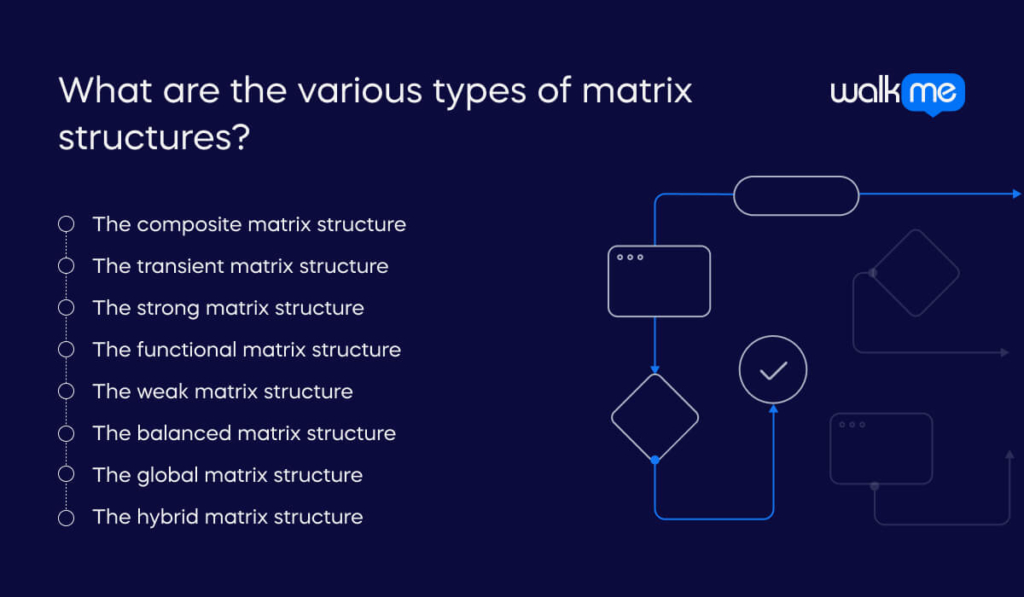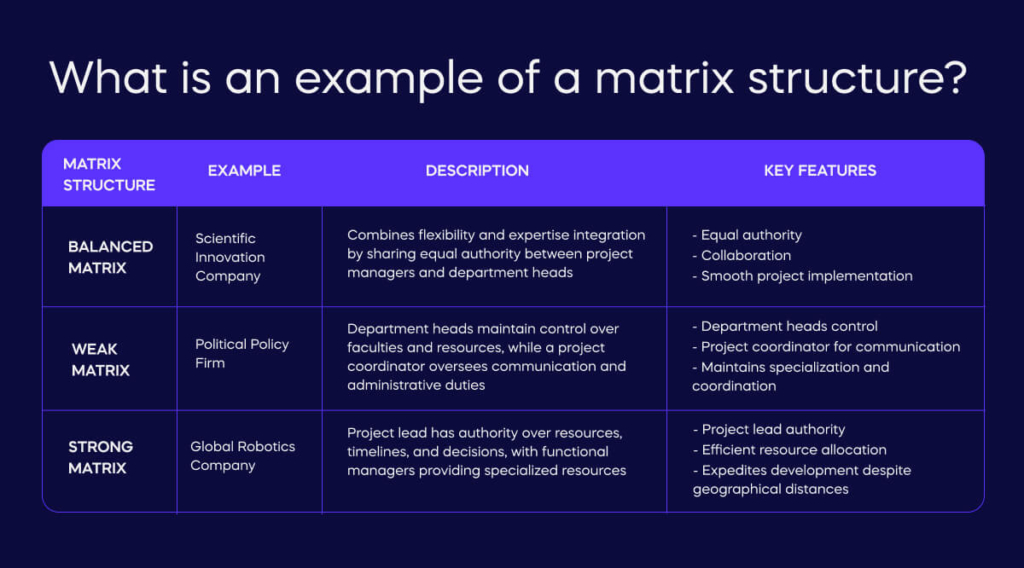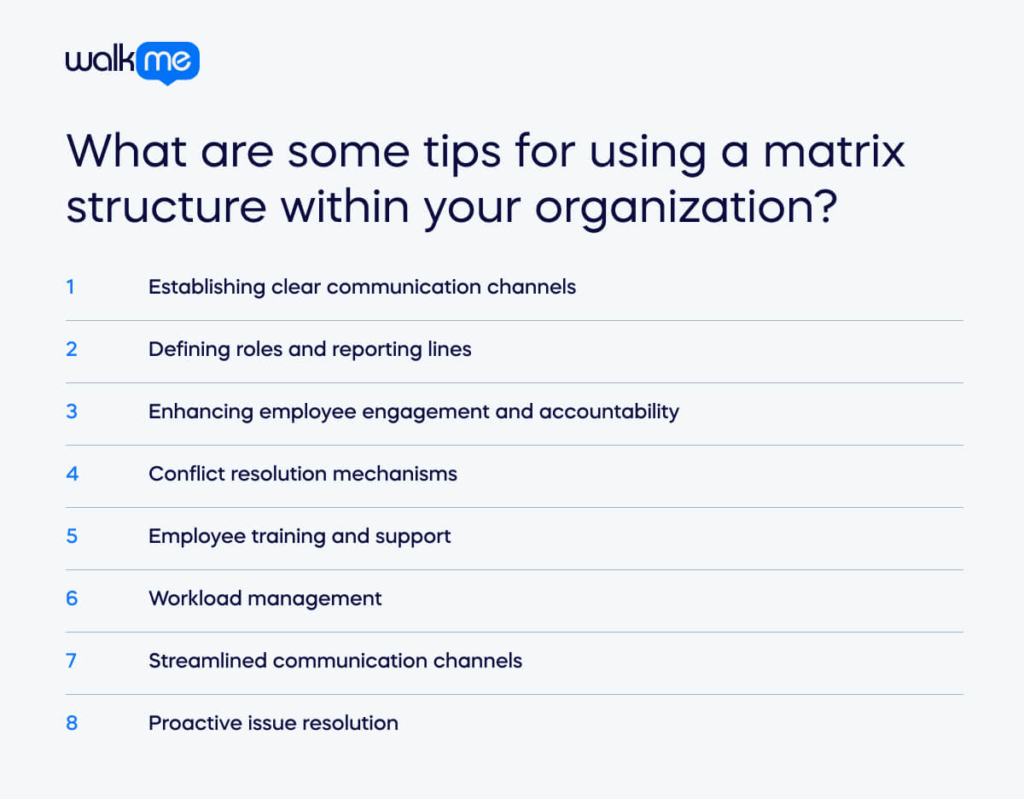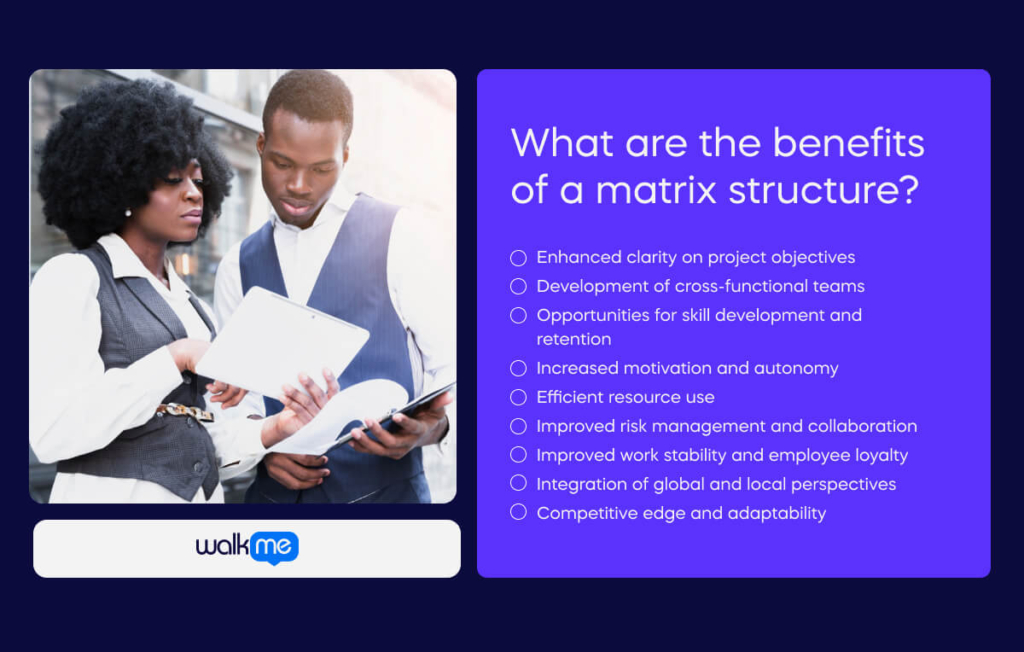Most organizations follow a linear reporting structure. It has clear roles and responsibilities, and employees report to a single superior. However, traditional hierarchical models struggle to help large-scale projects involving cross-functional teams. This is where the matrix organizational structure becomes useful.
The matrix structure deviates from the single-chain-of-command method. This is because it incorporates dual reporting lines within a grid-like format. Under this framework, employees have a reporting relationship with two types of managers. These are a functional manager and a product or project manager. This new structure addresses issues like miscommunication and slow decision-making.
In this article, we will explore what matrix structure is. It will also detail when you can use it and its various types. Then, it will discuss the advantages and difficulties of the structure. We will also provide implementation tips with an example.
What is a matrix structure?
The matrix structure combines different organizational frameworks, such as project and functional management. It merges functional managers with project managers to supervise cross-departmental teams. The intersection of these managerial systems creates a grid or matrix.
How does a matrix structure work?
Organizations that use a matrix structure have several management reporting channels. Although complicated, team members usually report to a departmental manager.
The way employees report to a department manager reflects traditional work arrangements. For instance, PR team members report to the PR department head. This head reports to the divisional vice president, leading up to the CEO.
A matrix organization has several defining elements. Dual reporting is essential, requiring employees to report to many supervisors. Also, cross-functional teams collaborate to achieve project or organizational objectives. This enhances collaboration across different departments.
Sharing equipment, facilities, and personnel supports the efficient allocation of resources. Teams that focus on projects or products improve their ability to be agile. Flexible roles and responsibilities encourage versatility in employees. It also gives them more of a comprehensive view of the business.
Functional managers in this structure supervise departmental goals. They also report to department heads and prioritize employee growth and compliance. Project managers organize and supervise projects. They focus on resource allocation, budgeting, timelines, and achieving objectives.
When should you use a matrix structure within your organization?
Companies can use the matrix structure to balance daily operations and ongoing projects. This ensures departmental integrity during project execution. This structure encourages collaborative project work by including employees from different departments. It also maintains the stability of functional roles in the organization.
The agile matrix structure provides the necessary flexibility to meet strict project deadlines. It works for companies with many departments and diverse geographical operations. The emphasis is on building strong team dynamics and optimizing employee training.
Additionally, the matrix structure fosters open communication within the company. Its fluid nature promotes seamless collaboration among teams and employees. Having a clear flow of information is vital for the functioning of this structure.
What are the various types of matrix structures?

The various types of matrix organizational structures are:
The composite matrix structure
This matrix structure enhances project management abilities. It does this through increased collaboration between functional and project managers. Employees with dual supervisors focus on tasks and divide resources. This promotes communication and accountability. This structure is also perfect for organizations that have many projects.
The transient matrix structure
This matrix structure handles complex and dynamic projects by prioritizing flexibility and adaptability. It is ideal for projects in uncertain environments and changing requirements. This is because it enables quick adjustments and resource reallocation.
The strong matrix structure
In a strong matrix structure, the project manager has more decision-making power, but the department head has limited authority. This arrangement fosters a resilient organizational framework. It enables the project manager to have full ownership of the project. The department head maintains oversight responsibilities but lacks pivotal decision-making authority.
The functional matrix structure
The functional matrix structure separates responsibilities between functional and project managers. The functional manager handles daily operations, while the project manager ensures timely project completion.
The weak matrix structure
The weak matrix structure grants project managers limited authority. Functional managers hold most of the power and authority here. The project manager will only act in an advisory role or coordinate functions.
The balanced matrix structure
The authority distribution is more balanced in this matrix structure. This benefits both the functional and project managers. The project manager receives updates from team members about project-related matters. This structure also allows them some flexibility in decision-making for the project.
The global matrix structure
The global matrix structure enables effective project management across regions and markets. It does this by integrating functional, divisional, and geographic aspects. It promotes coordination among international teams. It also permits decentralized decision-making in each geographic area.
The hybrid matrix structure
The hybrid matrix offers adaptability and personalization. It does this by combining many matrix structures to suit project needs. It allows clear lines of authority. This facilitates problem-solving and knowledge sharing. Thus, it is ideal for diverse industries and organizations with specific requirements.
What is an example of a matrix structure?

There are various matrix structure examples, depending on the type adopted:
Balanced matrix example
In the dynamic landscape of scientific innovation, companies often juggle many projects. It requires diverse expertise from departments like engineering, procurement, and quality assurance.
A balanced matrix structure is invaluable because it combines flexibility and expertise integration. By sharing equal authority, project managers and department heads can collaborate. This arrangement guarantees smooth project implementation, fostering innovation and success within the organization.
Weak matrix example
A political policy firm chooses a weak matrix structure to plan a research project. One can do this to capitalize on department heads’ diverse expertise. The structure allows department heads to maintain control over their faculties and resources.
It ensures alignment with their respective areas of specialization. At the same time, a project coordinator oversees communication and administrative duties. This fosters coordination and maintains project cohesion.
Strong matrix example
A global robotics company embarks on developing new software, spanning teams across continents. Opting for a strong matrix setup allows efficient resource allocation. It also expedites development despite geographical distances. The project lead has authority over crucial project aspects. These include resources, timelines, and critical decisions. Functional managers provide specialized resources to foster collaboration and ensure project success.
What are some tips for using a matrix structure within your organization?

Here are some tips on implementing a matrix structure within your business:
Establishing clear communication channels
Encourage consistent communication between team members. This will prevent issues caused by assumptions and promote productive collaboration.
Defining roles and reporting lines
Outline the roles and responsibilities of project and functional managers before adoption. This avoids conflicts and confusion. Make sure all team members know their reporting lines and who to contact for specific issues. This reduces ambiguity and improves workflow efficiency.
Enhancing employee engagement and accountability
Create strategies to improve employee engagement and foster accountability during project planning. It is important to establish regular progress reports from employees. This will track completed tasks and ensure accountability.
Conflict resolution mechanisms
Create mechanisms for resolving disagreements constructively. Empower employees by offering regular training in negotiation, mediation, and communication. This will help them achieve effective conflict resolution and positive team dynamics.
Employee training and support
Invest in training for employees to familiarize them with the matrix structure. Offer help and direction to cut the learning process. This will enhance efficiency and ease a seamless shift to the new framework.
Workload management
Track employee workloads to prevent burnout and maintain productivity. This is true for those managing many projects. Ensure manageable workloads and optimal performance by providing support and redistributing tasks as necessary.
Streamlined communication channels
Create guidelines for managers and team members to communicate regularly. This will facilitate efficient project updates and departmental alignment.
Proactive issue resolution
Identify possible problems in the matrix structure and establish communication channels to address them in advance. This will prevent small concerns from becoming big obstacles and ensure that the project runs well.
What are the benefits of a matrix structure?

The most common benefits of a matrix structure are:
Enhanced clarity on project objectives
Reporting to both heads ensures alignment with project objectives. It also solidifies project goals.
Development of cross-functional teams
Cross-functional teams in a matrix structure enhance organizational agility and competitiveness. It does this by responding to market changes and evolving project needs.
Opportunities for skill development and retention
The matrix model encourages staff rotation to promote skill diversification and knowledge acquisition. Enhanced employee efficiency benefits both the company and staff, fostering employee retention.
Increased motivation and autonomy
A matrix structure gives employees more autonomy and input in projects. This increases motivation. Clear reporting lines and task management foster teamwork and communication, which boosts motivation.
Efficient resource use
Matrix structures optimize resource use by forming specialized teams from different departments, reducing overhead costs and project completion time. Cross-functional teams with diverse skill sets enhance problem-solving and project quality.
Improved risk management and collaboration
Matrix structures with cross-functional teams improve risk management. They do this by incorporating diverse viewpoints and facilitating efficient communication. The presence of dual reporting lines simplifies risk monitoring. It also reduces the chance of expensive setbacks.
Improved work stability and employee loyalty
Matrix organizations foster work stability, resulting in increased employee loyalty. Thus, employees feel less anxious about their job status. As a result, they become motivated and work hard to ensure project success.
Integration of global and local perspectives
Matrix structures allow organizations to customize strategies to local market needs by integrating global and local viewpoints. It enhances market expansion, customer experience, and competitiveness.
Competitive edge and adaptability
Matrix structures enable organizations to adapt to market changes. It can also help seize new opportunities and meet evolving customer needs. As a result, companies can speed up product development, surpassing rivals, and become leaders in the industry.
What are the challenges of a matrix structure?

Like any organizational structure, the matrix model has its limitations. These are:
Slow response times and information relay
Information reported to many individuals can lead to slow response times. While it can be beneficial to involve more people, this hinders project advancement.
Impact on employee performance
Unclear roles and responsibilities can affect employee performance in matrix organizations. Employees may become overwhelmed due to conflicting tasks and expectations from many managers. This results in decreased employee productivity and efficiency. The lack of clear reporting lines worsens the problem. This makes it difficult for managers to exercise their authority.
Potential managerial discord
Conflicting expectations among managers in matrix structures can cause team members to feel confused and divided. Clarity on responsibilities and authority is crucial to ensure better project execution.
Resistance to change and transition challenges
Implementing a matrix structure is often met with resistance. This can be from employees who are used to traditional hierarchies. A well-planned change management strategy is necessary to ensure the implementation goes well. This is due to concerns about role ambiguity, power dynamics, and increased managerial complexity.
Work overload and performance tracking
Team members may experience work overload. This is because of balancing project and functional responsibilities within matrix structures. Burnout, task oversight, or reduced work quality may result from this. Tracking employee performance in matrix organizations is difficult due to many roles and unclear reporting lines.
Complexity and confusion
The complexity of matrix organizations can confuse team members. This impacts projects and productivity. The difficulty of prioritizing tasks and managing time worsens these challenges.
Increased costs and talent management
Hiring and administrative costs rise due to the need for many managers in matrix structures. To assess the effectiveness of the investment, organizations need to consider these expenses in relation to potential productivity gains. Furthermore, talent management problems can occur when managers limit the mobility of skilled employees, which impacts organizational performance.
Ambiguity in decision-making authority
Decision-making authority can be ambiguous in matrix structures with many supervisors. This makes it difficult to determine the final say in critical choices. This uncertainty can hinder project progress and undermine effective leadership.
What are the alternatives to a matrix structure?
If the matrix structure does not work for you, here are some alternatives to consider:
Functional structure
A functional organizational structure categorizes employees based on their specific skills and functions. The higher-ranking positions are at the top. Each department functions independently, prioritizing its specific role.
Divisional structure
The divisional structure arranges employees according to their job duties or skills. Nonetheless, every division functions independently and reports to a manager. This model is suitable for companies with varied product lines, enabling each division to concentrate on its offerings.
Network structure
The network structure arranges employees according to their job roles or responsibilities. It depends on external relationships with departments or even other companies. Its flexibility makes it perfect for quick growth or market entry. You can do this without needing to hire more people.
Circular Structure
Organizational leaders position themselves at the center of a circular structure. This promotes communication in all directions instead of a top-down approach. It also allows a holistic approach to departments. This results from dismantling barriers and fostering unity among employees.
Flat Structure
Unlike hierarchical pyramids, flat structures reduce management levels, bringing staff closer to leadership. As a result, employees may feel more equal to their managers. This boosts productivity and morale.
What is the future of a matrix structure?
Companies undertaking vast and complex projects will find the matrix organizational structure helpful. This could be when processing large amounts of information or accessing specialized skills.
It allows collaboration among employees from diverse divisions. This is useful when projects need collective skill sets to achieve common goals. However, it can also result in slower decision-making, potential conflicts, and heavier workloads.
Despite the obstacles, many companies find the matrix structure helpful, enhancing efficiency.
Before adopting this model, companies need to analyze their requirements and goals and consider the pros and cons. The expenses and intricacy of implementing a matrix structure can discourage certain organizations.
FAQs
Matrix structures allow dynamic allocation of skilled employees across functional and project teams, maximizing expertise utilization and reducing idle capacity.
Dual reporting to functional and project managers can cause conflicts in priorities and authority, potentially stalling decisions unless roles are clearly defined.
A balanced matrix suits organizations where neither functional depth nor project focus should dominate—ideal when both require equal leadership and collaboration.
Address ambiguity with explicit role definitions, accountability frameworks, and communication protocols to ensure clarity and prevent confusion among team members.

